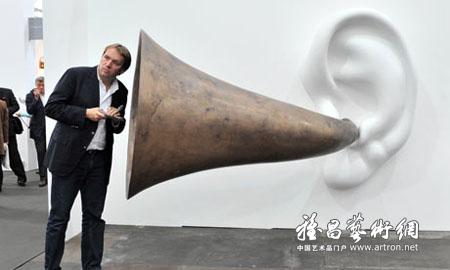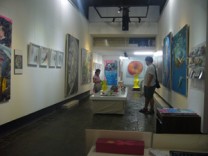Frieze Art Fair: not deaf to the times
2011-04-15 11:33:10

Beethoven's Trumpet (with Ear) Opus #133, by John Baldessari
There is plenty to stare at in Frieze, and it's not just the art. On Thursday, during the VIP/press opening, it was hard not to be diverted from the multiple Hirsts, Wallingers, Quinns by work just as expensive and visually arresting. The cosmetic surgery on view varied from perma-surprise to Bride of Wildenstein, and the handbags were equally arresting: I met a fashion journalist friend who was noting Hermès bags in his notebook like a prisoner marking off the days before release.
But if you could drag your eyes from the drag queens, the dealers, the bankers, the you-know-whats, and square the £25 it cost for a daily pass, then there was plenty to delight. Although this year's curated works were hit and miss: Monika Sosnowska's much anticipated piece, a replica of Warsaw's palace of culture crashing into Frieze's ceiling, was removed at the request of the artist, leaving just a dent in a tent. Superflex's The Financial Crisis film, of a hypnotist giving us techniques to cope with the recession, might have worked if the hypnotist himself hadn't been so hypnotically dull.
Better was the installation from Kim Coleman & Jenny Hogarth, busy CCTV-ing directed actors as well as real visitors to the fair and then combining the images in a claustrophic, curtained room. Inspired partly by Jacques Tati, this was entertaining comment on how much posing goes on at such events, how we act as we think we ought. And I liked Ryan Gander's photographs of visitors looking at pieces of work at Frieze. Full face, black and white, individual portraits, they were marshalled along the entrance corridor. Art needs an audience, whether receptive, quizzical, inspired or paying.
Stephanie Syjuco's corner stall was never less than buzzy. The artist recruited other artists to recreate work on display at the fair, using cheaper materials. There they were, hard at work, sampling, bootlegging, homaging. "I like to think of these as karoake versions," she said. The resulting pieces, made of clay and cardboard, sticky tape and spray paint, were selling for between £100 and £500, and made you think about how art is valued. Does a piece of work have an aura of its own that makes it special? Is it given its worth by the artist that made it? By the materials that are used? By the value the market gives it?
Back to the sell, sell, sell of the galleries, Frieze's real deal. Compared with the recklessness of the boom years, the dealers seemed, if not conservative, then careful with the artwork they chose to display: there were a lot of hangable works by big name artists, enormous photographs and paintings that would look fantastic showing out in your penthouse apartment or corporate office. Not so many tricky installations (though Sadie Coles was a notable exception, showing Gabriel Kuri's self portraits: plastic bags filled with water and what looked like wee). Still, it was fun to go around, clocking names. Tracey Emin, Julian Opie, Lee Bul had pieces in more than one gallery, creating a strange deja-vu effect. There were also works by older artists, such as Weegee. Sigmar Polke's enormous painting of pixelated cartoon figures (a rabbit? A drinking man?) was exciting to see. As was an almost indiscernible piece of pointed wire that moved slowly in and out of a wall: Charles Ray, surely the quietest piece on show.
But it was Frame, a new area introduced by Frieze's directors, Matthew Slotover and Amanda Sharp, that proved the place to hang out. Twenty-nine galleries under six years old showed just one of their artists in each generous space: as though a piece of Zoo, Frieze's fringe art fair, now moved to east London, had sneaked into the big boy's club. I enjoyed Ancient & Modern's offering: Alan Kane's display of his mother's favourite artefacts. China ladies, a cute clay sheep, a Virgin airways thimble stood proud on plinths. On the walls: a collage of cut-out family photos and a snap of his mum and dad meeting the pope. Slightly crazily for an art fair, none was for sale – Alan's mum wants them all back. There were free postcards, however, pictures of a very personal art collection for you to collect yourself.
In Limoncello, Jack Strange was one of very few artists to use modern techniques, presenting a selection of laptops flickering with high-speed images and garbled sounds taken from his subjects' lives and iPods – up-to-the-minute portraiture. Just behind, at Franco Soffiantino, Katerina Šedá showed nine drawings, made up of the single line contributions of 300 people from her local village in the Czech Republic. At Seventeen, Sarah Collis's trompe l'oeil pieces of seemingly worthless wood and metal, inlaid with precious jewels, were attracting attention.
And at Lüttgenmeijer, Canadian artist Gareth Moore's playful installation, of chair parts found in Berlin, had been bought lock stock by the Tate. Moore had reimagined the chairs as a series of flags, waving. Saying, see! you dismissed us as finished, but here we are, back again. If not useful, then pretty, at least.

 黄琦
黄琦 测试用艺术
测试用艺术
